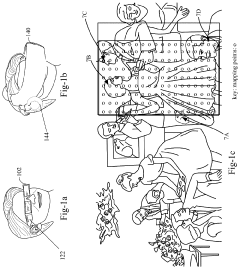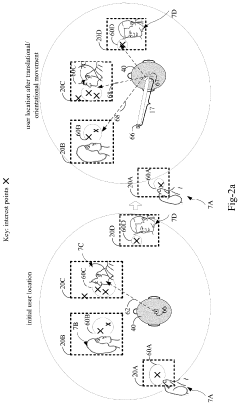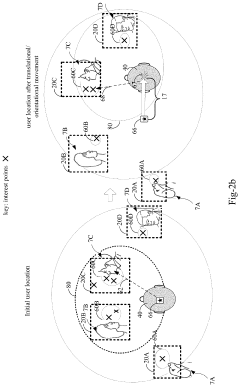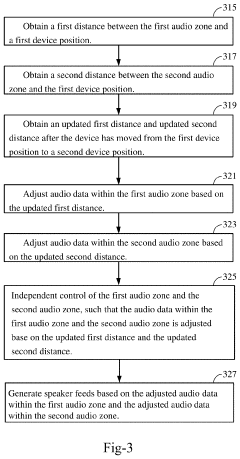Research on augmented and virtual reality technologies - Eureka
OCT 8, 20244 MIN READ
Generate Your Technical Report in Patsnap Eureka
AI-Powered Innovation Solution Platform for R&D
AR/VR Technology Background and Goals
The primary objective is to provide a comprehensive overview of the development history and evolution trends in the field of augmented and virtual reality (AR/VR) technologies. This section will trace the key milestones and breakthroughs that have shaped the progress of AR/VR, shedding light on the driving forces behind its advancement. Additionally, it will clearly define the expected technological goals and capabilities that AR/VR solutions aim to achieve, setting the stage for the subsequent analysis and exploration of this rapidly evolving domain.
By establishing a solid understanding of the technological background and objectives, this section lays the foundation for a thorough examination of the market demands, current state, challenges, and future directions of AR/VR technologies in the subsequent sections of the report.
By establishing a solid understanding of the technological background and objectives, this section lays the foundation for a thorough examination of the market demands, current state, challenges, and future directions of AR/VR technologies in the subsequent sections of the report.
Market Demand for AR/VR Solutions
- Growing Demand for Immersive Experiences
Consumers and businesses seek more engaging and interactive experiences, driving demand for AR/VR solutions across various sectors like gaming, entertainment, education, and training. - Enterprise Applications
AR/VR technologies offer significant potential for enhancing productivity, efficiency, and safety in industries such as manufacturing, healthcare, construction, and logistics through applications like remote assistance, virtual training, and data visualization. - Retail and Marketing
AR/VR solutions enable innovative marketing strategies, product visualization, and virtual try-on experiences, enhancing customer engagement and driving sales in the retail sector. - Healthcare and Medical Training
AR/VR technologies facilitate advanced medical training, surgical planning, and patient education, improving healthcare outcomes and enabling more effective knowledge transfer. - Tourism and Travel
Virtual tours and immersive experiences offer a unique way to explore destinations, attractions, and accommodations, creating new opportunities for the tourism industry.
Current State and Challenges in AR/VR
- Technical Limitations
Current AR/VR technologies face several technical limitations, including:- Limited field of view and resolution
- Lack of realistic haptic feedback
- High computational demands for rendering
- Hardware Constraints
The hardware required for AR/VR experiences is still bulky, expensive, and power-hungry, limiting widespread adoption.- Headsets are often heavy and uncomfortable for extended use
- High-end GPUs and processors are required for smooth performance
- User Experience Challenges
- Motion sickness and disorientation are common issues
- Lack of natural interaction methods and intuitive user interfaces
- Content Creation Difficulties
Creating high-quality, immersive AR/VR content is complex and resource-intensive, requiring specialized skills and tools. - Privacy and Security Concerns
AR/VR technologies raise privacy and security concerns, such as data collection, user tracking, and potential misuse of personal information.
Evolution Path of AR/VR Technologies

Current AR/VR Solutions and Implementations
01 Devices and systems for AR and VR
Various devices and systems for enabling augmented reality (AR) and virtual reality (VR) experiences, including head-mounted displays, mobile devices, and hardware components for rendering virtual objects and environments, with sensors, cameras, and components for tracking user movements and interactions.- Devices and systems for AR and VR: Various devices and systems for enabling AR and VR experiences, including head-mounted displays, mobile devices, and hardware components for rendering virtual objects and environments, with some systems combining AR and VR capabilities for seamless transitions between the two modes.
- Interaction and manipulation of virtual objects: Methods and techniques for interacting with and manipulating virtual objects in AR and VR environments, including user interfaces, gesture recognition, and other input mechanisms that allow users to control and manipulate virtual objects in a natural and intuitive manner.
- Transitioning between AR and VR modes: Systems and methods for seamlessly transitioning between augmented reality (AR) and virtual reality (VR) modes, allowing users to switch between experiencing virtual objects overlaid on the real world (AR) and fully immersive virtual environments (VR), enabling a range of applications and use cases.
- AR and VR for training, education, and simulation: Utilization of AR and VR technologies for various training, educational, and simulation purposes, allowing users to experience simulated environments, practice tasks, and learn in an immersive and interactive manner, enhancing the learning experience.
- Integration with other technologies: Techniques for integrating AR and VR with other technologies, such as cloud computing, data centers, and digital assistants, enabling enhanced functionality, data processing, and intelligent interactions within AR and VR environments.
02 Transitioning between AR and VR environments
Techniques for seamlessly transitioning between augmented reality (AR) and virtual reality (VR) environments, involving switching between displaying virtual objects overlaid on the real world (AR) and fully immersive virtual environments (VR), based on user input, environmental conditions, or other factors.03 Interaction with virtual objects
Methods and systems for enabling users to interact with virtual objects in AR and VR environments, including techniques for selecting, manipulating, and controlling virtual objects using various input methods, such as gestures, gaze tracking, or controllers.04 Integration with other technologies
Approaches for integrating AR and VR with other technologies, such as cloud computing, data centers, and digital assistants, leveraging AR and VR for visualizing and interacting with data, infrastructure, or virtual environments in various applications.05 Development and creation of AR and VR experiences
Systems and methods for creating and developing AR and VR experiences, including tools and platforms for designing virtual environments, simulating real-world locations, and generating AR and VR content for various applications, such as gaming, training, or entertainment.
Key Players in AR/VR Industry
The augmented and virtual reality (AR/VR) technology market is rapidly growing, driven by increasing applications across various sectors. Key players like Meta Platforms, Microsoft, and Apple are leading with mature AR/VR solutions, while companies like Magic Leap, Qualcomm, Guangdong Virtual Reality Technology, and Realmax are enhancing the competitive landscape.
Meta Platforms Technologies LLC
Technical Solution: Meta offers advanced VR headsets like Oculus Quest 2, with high-resolution displays and intuitive hand tracking. It's investing heavily in the Metaverse for interconnected virtual worlds.
Strength: Leading VR hardware and software ecosystem. Weakness: High competition and privacy concerns.
Samsung Electronics Co., Ltd.
Technical Solution: Samsung offers Gear VR, a mobile VR headset compatible with its smartphones. It's investing in AR through features like AR Emoji and Bixby Vision, leveraging its display and hardware expertise.
Strength: Strong hardware capabilities and mobile device integration. Weakness: Reliance on smartphone compatibility limits standalone VR capabilities.
Core Innovations in AR/VR Technologies
Rendering audio data from independently controlled audio zones
PatentActiveUS20200053505A1
Innovation
- The independent control of the audio zones, allowing for adjustment based on the updated distance, and the ability to generate speaker feeds based on the adjusted audio data.
Regulatory and Ethical Considerations in AR/VR
Augmented and virtual reality (AR/VR) technologies have witnessed significant advancements, enabling immersive experiences that blend digital content with the physical world. The market demand for AR/VR solutions is driven by applications across various sectors, including gaming, entertainment, education, and industrial training. Key players like Meta, Microsoft, and Google are investing heavily in this domain, shaping the competitive landscape. Current mainstream solutions involve head-mounted displays, spatial tracking, and advanced rendering techniques. Core innovations revolve around optics, display technologies, and sensor fusion algorithms. Potential future directions include seamless integration of AR/VR with other emerging technologies like 5G, edge computing, and artificial intelligence for enhanced user experiences and broader adoption.
the structure of the environmentally friendly knitted fabric provided by the present invention; figure 2 Flow chart of the yarn wrapping machine for environmentally friendly knitted fabrics and storage devices; image 3 Is the parameter map of the yarn covering machine
Login to View More Environmental Impact of AR/VR Technologies
Augmented and virtual reality (AR/VR) technologies have witnessed significant advancements, enabling immersive experiences that blend digital content with the physical world. The market demand for AR/VR solutions is driven by applications across various sectors, including gaming, entertainment, education, and industrial training. Key players like Meta, Microsoft, and Google are investing heavily in this domain, shaping the competitive landscape. Current mainstream solutions involve head-mounted displays, spatial tracking, and advanced rendering techniques. However, challenges persist in areas like display resolution, battery life, and motion sickness. Future innovations may focus on lightweight, power-efficient hardware, improved tracking accuracy, and seamless integration of virtual and real environments.
the structure of the environmentally friendly knitted fabric provided by the present invention; figure 2 Flow chart of the yarn wrapping machine for environmentally friendly knitted fabrics and storage devices; image 3 Is the parameter map of the yarn covering machine
Login to View More If you want an in-depth research or a technical report, you can always get what you want in Patsnap Eureka TechResearch . Try now!



